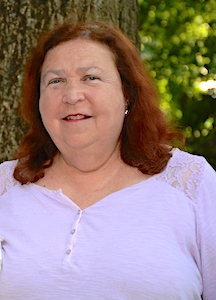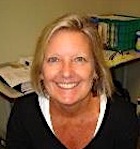Formative Assessment Fuels Literacy Learning
By Lynne Dorfman and Brenda Krupp
Formative assessment is a key element in learning how to be a reflective practitioner who adjusts literacy instruction in ways to meet students’ needs and interests.
We want to use formative assessment to breathe life into our reading and writing lessons and across the day, not to replace valuable instruction time with unnecessary assessment time.
We want to help our learners understand that they have ownership in the assessment process. Our students must also come to realize that they have responsibilities: setting and reaching goals, asking questions, sharing with others, revising their thinking, and taking risks to grow as readers, writers, and learners. These things put energy into all the time we spend together.
According to Peter Johnston, “The heart of formative assessment is finding the edge of students’ learning and helping them to take up responsibilities for growth. Assessment isn’t formative if it doesn’t influence learning in a positive way” (2012, 49).
Johnston suggests that teachers and students in the learning community are jointly responsible for providing the interactions that shape us as we grow. We believe these experiences, including each student’s ability to assess his own learning and take note of the learning of his peers, will help all readers move forward.
Noticing and retaining successful practices as we participate in individual conferences, whole-group discussions about literature, share sessions, and reflection time is all part of formative assessment.
An NCTE position statement tells us that “Formative assessment is a constantly occurring process, a verb, a series of events in action, not a single tool or a static noun” (“Formative Assessment That Truly Informs Instruction,” 2013, 3).
One of our hardest jobs is to build in time each day for formative assessment practices such as taking some notes as we observe our students as readers. But we cannot stop here. The most difficult part of this process is to also find the time to analyze the data we have gathered and decide what to do with it!
Keeping formative assessment upfront
As teachers we strive to connect the ongoing work we do each day with our evaluation of that work. The goals of formative assessment are many, but the goals to keep in the foreground of the work we do with children include the following:
• Monitor student learning
• Use knowledge gleaned from observations, conferences, rubrics, checklists, class discussions, and writing samples to inform instruction (teacher)
• Use feedback to try new things, set goals, evaluate progress toward goals, and help students build and celebrate strengths while becoming more confident and competent.
Of course, we must understand that formative assessment is not one thing, and it is not a one-time event. Gathering and reflecting on feedback is a process that should be built into daily routines. According to Regie Routman (Reading Essentials, Heinemann, 2003, p. 99), “As much as possible, we teachers need to do our own ongoing assessments with our students using materials that students are already reading or likely to read. Our own assessments are the ones that really drive instruction.”
Formative assessment may be formal or informal. Sometimes it is planned, like clipboard cruising during independent reading and writing time to observe readerly and writerly behaviors. Sometimes an occasion arises when we know now is the time to be creating an anchor chart, or taking notes or photos, or even making a short videoclip.
Throughout each week, we need to be constantly evaluating whether students have learned what we intended – and then we need to use that information to drive instruction. (Watch for our future article on running records, a useful process to systematically gather formative assessment information.)
Conferencing as formative assessment
Conference notes that show us what our students can do as readers and writers provide us with knowledge we can use to plan minilessons, decide on small group composition and instruction, and set individual goals and instructional plans.
Our notes give us valuable information about our readers and inform our teaching practices with the individual reader and the class. Taking time to write notes while conferring, add thoughts immediately after the conference; and later review and reflect on them at some point in the day, enables us to plan for instruction as we assess the reader or the writer.
When taking notes we always want to consider what the child is showing us through their words and actions. If we’re going to assess students frequently, we need some quick, easy strategies.
Consider creating a conference note form that you are comfortable with and that will help you set doable goals with your students. Here are two examples for a writing conference:
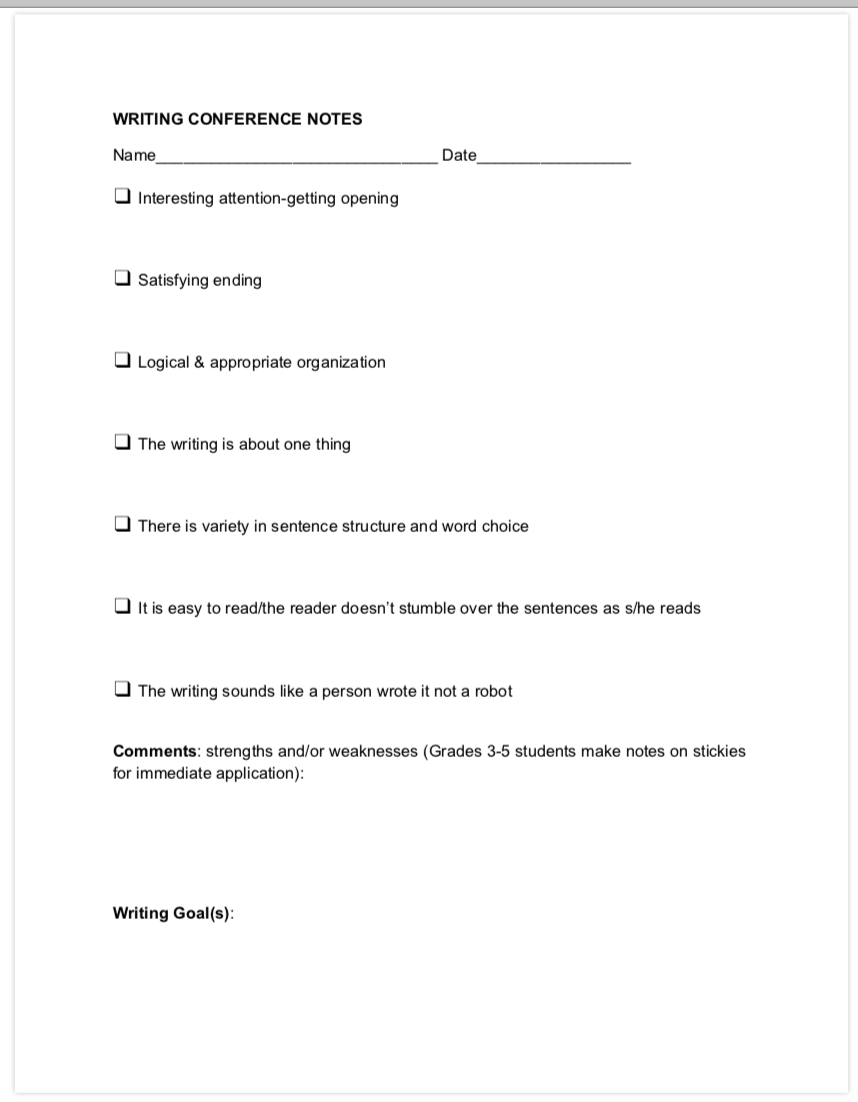
Here is another possibility to consider for writing conferences in grades 4-8:
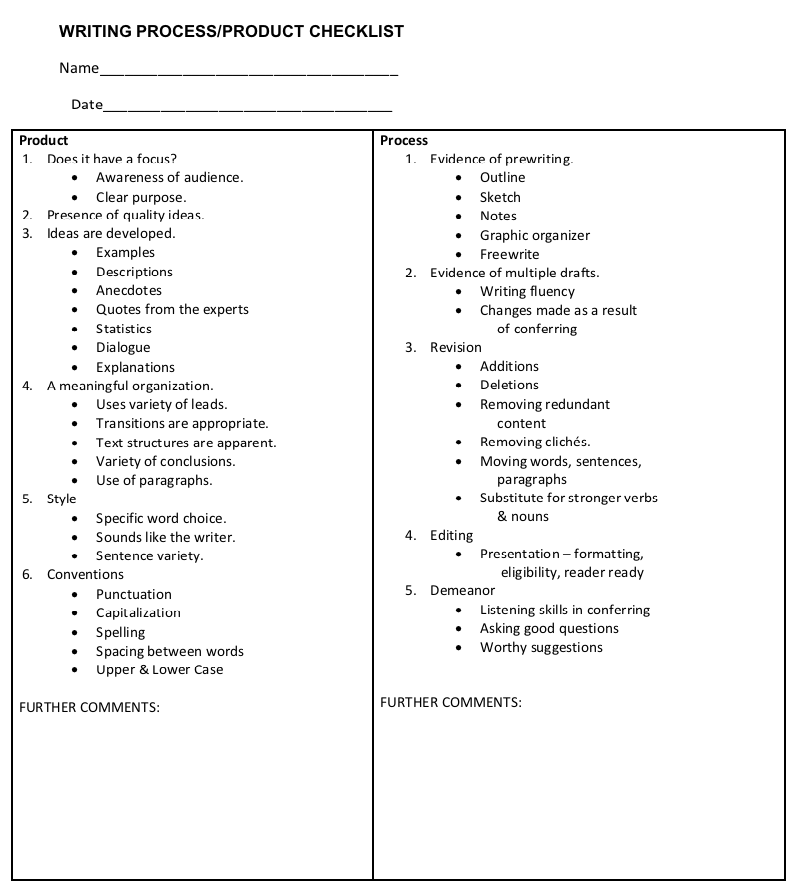
Interest Surveys & Inventories
Interest surveys and inventories can also be used as we begin a new unit of study. We might want to learn more about our readers as readers of nonfiction (or memoir or biography or fantasy, etc.) before embarking on a unit that focuses on reading informational text.
Surveying Students Before
Starting a New Unit or Genre Study
Example Questions – Informational Text
Students could respond to questions like these:
- An informational book I have read is …
- When reading informational books, I like to read about …
- This is how I read an informational book …
- This is what I know about how informational texts are organized…
- When I’m done reading an informational book this is what I want to do …
- One thing I’d like to learn about informational reading is …
Using students’ responses, we learn what students already know, what they need and want to know, as well as their feelings about this genre. The information can help us differentiate the learning in our classroom.
Exit slips: A quick and easy tool
Exit slips are a great formative assessment tool that can be used across the day. They take only a few minutes during class but can tell us a great deal.
Ask students to reflect and respond to an end of the class question like one of these:
- What do you now know about writing informational texts?
- Talk about something that you find confusing.
- Talk about what you worked hard on today.
- What worked well for you today?
- How did this article/play/chapter/poem make you feel? Why?
- What was the most important takeaway from today’s discussion (video, article, share/reflection time)?
You do not have to read everyone’s exit slip, but reading a sample from each class (if you are a middle or high school teacher) can help with your pacing. Do you need to review some important concepts? Can you speed things up? What are some strategies that are working for your students?
We also like to share back exit slips at the beginning of the next class we have together. We encourage our students to take notes to layer their thinking and become reflective learners. We find that sharing exit slips is a confidence builder and helps to bring students right back to that science, music, social studies, or ELA lesson they had the previous day.
We like to “clipboard cruise” while our students are sharing their exit slip responses in small groups to begin the next class session. The students often can help each other clear up areas of confusion – or they may agree that they need to raise a question or two if most or all group members want the teacher to offer more explanation or review a complex idea.
While providing teachers with an informal measure of how well students have understood a topic or lesson, exit slips also give students a voice in their daily learning, allowing them to express what or how they are thinking about new learning.
Something to Think About…
Sound assessment does play a vital role in showing and detailing progress students are making toward reasonable goals and helping educators monitor and adjust instruction in their classrooms.
Professional development opportunities that explore formative assessment practices may help school districts do a better job of supporting teachers and principals to use on-the-fly checks of learning to guide decision making and inform instructional practices.

Formative assessment can also significantly increase students’ level of participation and engagement. Teachers’ instructional practices change as they embrace new standards and new ways to assess progress daily, efficiently and meaningfully. Teachers can plan and review lessons after having a clear understanding of what they need to do. Formative assessment can focus on students’ needs, providing instant feedback and allowing teachers to customize, or differentiate, instruction on a day-to-day basis.
Engineering your mindset takes hard work, persistence, and a lot of self-talk and reflection. We are all a mix of fixed and growth mindsets, and we benefit from acknowledging the mix in ourselves and in our students, opening our minds to critical feedback and watching for personal biases (“I never was any good at writing”) that become roadblocks to learning.
References:
Johnston, Peter H. Opening Minds: Using Language to Change Lives. (Stenhouse, 2012)
Routman, Regie. “10 Actions That Put Student Writers First,” (MiddleWeb, August 2020)
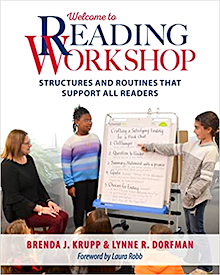
Brenda served as a classroom teacher, a lead teacher for Souderton Area School District, and a co-director for the summer invitational writing institute for the PA Writing & Literature Project (now The West Chester Writing Project) for over a decade.
Lynne is an adjunct professor for Arcadia University and keynoted at the 2021 KSLA Conference and has facilitated sessions at PCTELA Annual Conference, the Illinois Reading Conference in March, and the ADK Northeast Regional Conference in July. She is the co-author of several books from Stenhouse, including Welcome to Writing Workshop with Stacey Shubitz, and Mentor Texts, 2nd edition: Teaching Writing Through Children’s Literature (K-6) with Rose Cappelli.

